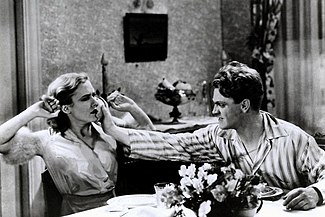
James Francis Cagney Jr. was an American actor and dancer. On stage and in film, he was known for his consistently energetic performances, distinctive vocal style, and deadpan comic timing. He won acclaim and major awards for a wide variety of performances.

Footlight Parade is a 1933 American pre-Code musical film directed by Lloyd Bacon, with songs written by Harry Warren (music), Al Dubin (lyrics), Sammy Fain (music) and Irving Kahal (lyrics). The film's numbers were staged and choreographed by Busby Berkeley. It starred James Cagney, Joan Blondell, Ruby Keeler and Dick Powell, with featured appearances by Frank McHugh, Guy Kibbee, Hugh Herbert, and Ruth Donnelly.

Angels with Dirty Faces is a 1938 American crime drama film directed by Michael Curtiz for Warner Brothers. It stars James Cagney, Pat O'Brien, The Dead End Kids, Humphrey Bogart, Ann Sheridan, and George Bancroft. The screenplay was written by John Wexley and Warren Duff based on the story by Rowland Brown. The film chronicles the relationship of the notorious gangster William "Rocky" Sullivan with his childhood friend and now-priest Father Jerry Connolly. After spending three years in prison for armed robbery, Rocky intends to collect $100,000 from his co-conspirator Jim Frazier, a mob lawyer. All the while, Father Connolly tries to prevent a group of youths from falling under Rocky's influence.

Mae Clarke was an American actress. She is widely remembered for playing Henry Frankenstein's bride Elizabeth, who is chased by Boris Karloff in Frankenstein, and for being on the receiving end of James Cagney's halved grapefruit in The Public Enemy. Both films were released in 1931.

Pre-Code Hollywood was an era in the American film industry that occurred between the widespread adoption of sound in film in the late 1920s and the enforcement of the Motion Picture Production Code censorship guidelines in 1934. Although the Hays Code was adopted in 1930, oversight was poor, and it did not become rigorously enforced until July 1, 1934, with the establishment of the Production Code Administration. Before that date, film content was restricted more by local laws, negotiations between the Studio Relations Committee (SRC) and the major studios, and popular opinion than by strict adherence to the Hays Code, which was often ignored by Hollywood filmmakers.
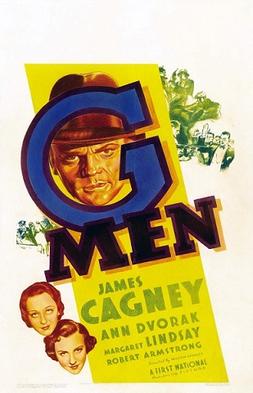
G Men is a 1935 Warner Bros. crime film starring James Cagney, Ann Dvorak, Margaret Lindsay and Lloyd Nolan in his film debut. According to Variety, the movie was one of the top-grossing films of 1935. The supporting cast features Robert Armstrong and Barton MacLane.

Waterloo Bridge is a 1931 American pre-Code drama romance war film directed by James Whale and starring Mae Clarke and Kent Douglass. The screenplay by Benn Levy and Tom Reed is based on the 1930 play Waterloo Bridge by Robert E. Sherwood.
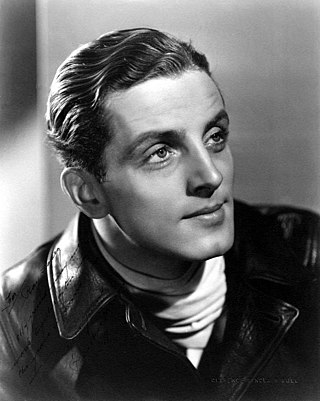
Phillips Raymond Holmes was an American actor. For his contributions to the film industry, he was posthumously given a star on the Hollywood Walk of Fame in 1960.
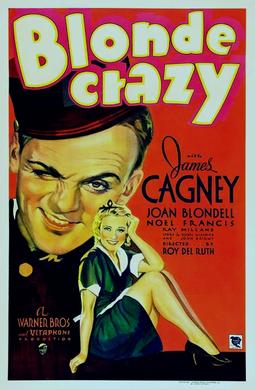
Blonde Crazy is a 1931 American pre-Code romantic comedy-drama film directed by Roy Del Ruth and starring James Cagney, Joan Blondell, Noel Francis, Louis Calhern, Ray Milland, and Guy Kibbee. The film is notable for one of Cagney's lines, a phrase often repeated by celebrity impersonators: "That dirty, double-crossin' rat!"

Taxi! is a 1932 American pre-Code film directed by Roy Del Ruth and starring James Cagney and Loretta Young.
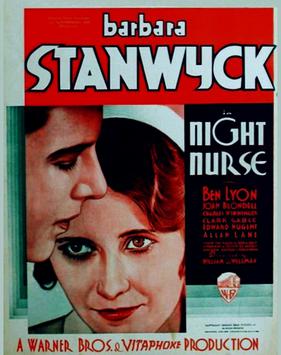
Night Nurse is a 1931 American pre-Code crime drama mystery film produced and distributed by Warner Bros. directed by William A. Wellman, and starring Barbara Stanwyck, Ben Lyon, Joan Blondell and Clark Gable. The film is based on the 1930 novel of the same name by Dora Macy, the pen name of Grace Perkins. The film was considered risqué at the time of its release, particularly the scenes where Stanwyck and Blondell are shown in their lingerie. Clark Gable portrays a viciously violent chauffeur who is gradually starving two little girls to death after having already purposely run over their slightly older sister with a limousine, killing her.

White Heat is a 1949 American film noir directed by Raoul Walsh and starring James Cagney, Virginia Mayo and Edmond O'Brien.
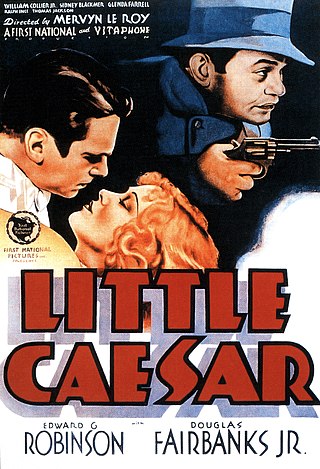
Little Caesar is a 1931 American pre-Code crime film distributed by Warner Brothers, directed by Mervyn LeRoy, and starring Edward G. Robinson, Glenda Farrell, and Douglas Fairbanks Jr. In 2000, Little Caesar was included in the annual selection of 25 motion pictures added to the National Film Registry of the Library of Congress being deemed "culturally, historically, or aesthetically significant" and recommended for preservation. The film tells the story of a hoodlum who ascends the ranks of organized crime until he reaches its upper echelons. The storyline, based on real life Mafia boss Salvatore Maranzano, was adapted from the novel of the same name by William R. Burnett. Little Caesar was Robinson's breakthrough role and immediately made him a major film star. The film is often listed as one of the first fully-fledged gangster films and continues to be well received by critics. The Library of Congress maintains a print.
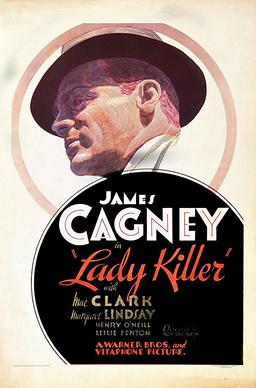
Lady Killer is a 1933 American pre-Code crime drama film starring James Cagney, Mae Clarke, and Margaret Lindsay, based on the story "The Finger Man" by Rosalind Keating Shaffer. The picture was directed by Roy Del Ruth.
Mafia films—a version of gangster films—are a subgenre of crime films dealing with organized crime, often specifically with Mafia organizations. Especially in early mob films, there is considerable overlap with film noir. Popular regional variations of the genre include Italian Poliziotteschi, Chinese Triad films, Japanese Yakuza films, and Indian Mumbai underworld films.

The Spy in the Green Hat is a 1967 feature-length film version of The Man from U.N.C.L.E.'s third season two-part episode "The Concrete Overcoat Affair". The episodes were originally broadcast in the United States on November 25, 1966 and December 2, 1966 on NBC. The film was directed by Joseph Sargent and written by Peter Allan Fields with the story by David Victor. Robert Vaughn and David McCallum star in the film as they do in the television series. It is the fifth such feature film that used as its basis a reedited version of one or more episodes from the series.
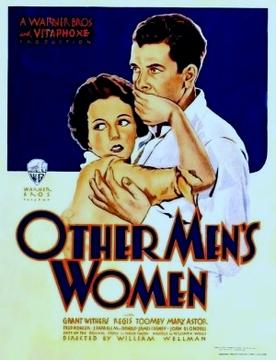
Other Men's Women is a 1931 American pre-Code drama film directed by William A. Wellman and written by Maude Fulton. The film stars Grant Withers, Regis Toomey, Mary Astor, James Cagney and Joan Blondell. It was produced and distributed by Warner Bros.

The Doorway to Hell is a 1930 American pre-Code crime film directed by Archie Mayo and starring Lew Ayres and James Cagney in his second film role. The film was based on the story A Handful of Clouds, written by Rowland Brown. The film's title was typical of the sensationalistic titles of many Pre-Code films. It was marketed with the tagline "The picture Gangland defied Hollywood to make!"

The era of American film production from the early sound era to the enforcement of the Hays Code in 1934 is denoted as Pre-Code Hollywood. The era contained violence and crime in pictures which would not be seen again until decades later. Although the Hays office had specifically recommended removing profanity, the drug trade, and prostitution from pictures, it had never officially recommended against depictions of violence in any form in the 1920s. State censor boards, however, created their own guidelines, and New York in particular developed a list of violent material which had to be removed for a picture to be shown in the state. Two main types of crime films were released during the period: the gangster picture and the prison film.
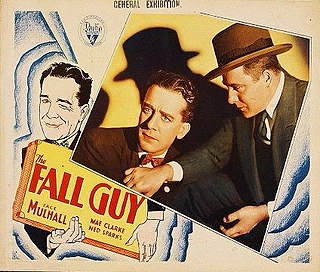
The Fall Guy is a 1930 American pre-Code crime drama film directed by Leslie Pearce and adapted for the screen by Tim Whelan. Based on the 1925 Broadway hit The Fall Guy, a Comedy in Three Acts, which was written by George Abbott and James Gleason, the RKO production stars Jack Mulhall, Pat O'Malley, and Mae Clarke. The year after this film's release, Clarke would become famous as a result of her minor role in another crime drama, The Public Enemy, in which James Cagney shoves a grapefruit into her face.


